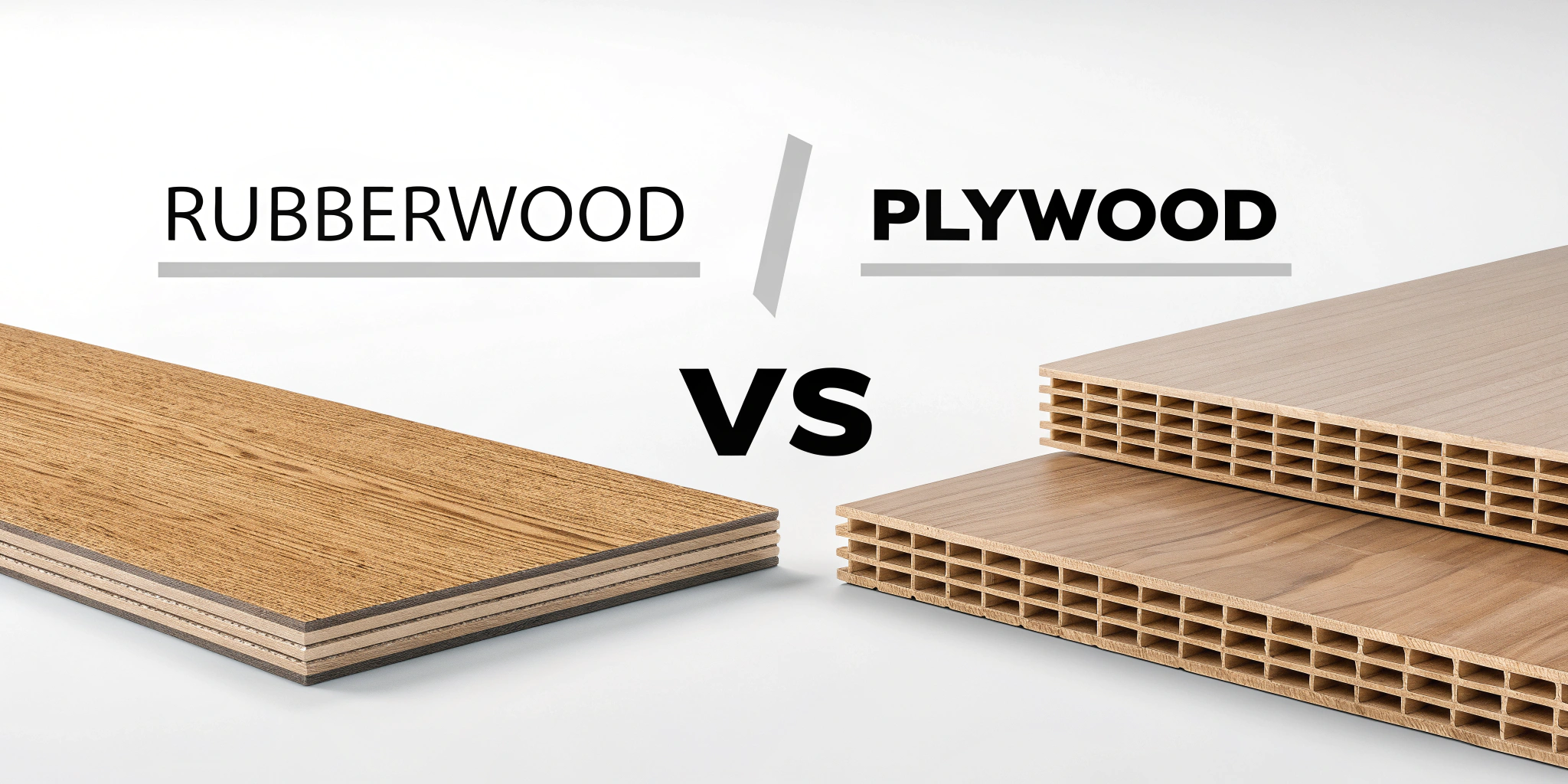Choosing the right material for furniture or interior projects is crucial, and two popular options are rubber wood vs plywood. While both materials are widely used, they differ in terms of composition, durability, appearance, and cost.
This article provides a detailed comparison of plywood vs rubberwood to help you make an informed decision for your next project.
What Is Plywood And Its Key Features
Plywood is versatile and used in various applications, from furniture to construction. The layers are arranged so that the grain of each layer is perpendicular to the previous one, giving plywood its unique strength and resistance to warping.
Plywood is an engineered wood product made by bonding thin layers of wood veneers together with adhesives.
Key Features Of Plywood
- Durability: Plywood is highly durable due to its cross-laminated structure. It holds screws and nails better than most solid woods.
- Variety: Plywood comes in different grades, thicknesses, and types (such as softwood, hardwood, and marine), making it adaptable to various needs.
- Moisture Resistance: Depending on the grade, plywood can be highly resistant to moisture, especially in the case of marine plywood.
- Cost: Plywood tends to be more affordable compared to many solid woods, offering good quality at a reasonable price.
What Is Rubberwood And Its Key Features
Rubberwood, also known as plantation hardwood, comes from the rubber tree, primarily grown in Southeast Asia. After the rubber tree stops producing latex, its wood is harvested for furniture and other uses. Rubberwood is considered eco-friendly because it repurposes a byproduct of the rubber industry.
Key Features Of Rubberwood
- Sustainability: Rubberwood is an eco-friendly option as it comes from rubber trees that have already served their primary purpose of latex production.
- Appearance: Rubberwood has a pale, light-colored grain, which is aesthetically pleasing and can be stained or painted to suit various design styles.
- Durability: While rubberwood is generally durable, it is softer than hardwoods like oak or maple, making it susceptible to dents and scratches.
- Cost: Rubberwood is affordable, often priced lower than other hardwoods, making it an economical choice for furniture.
Plywood vs Rubberwood: A Detailed Comparison
Rubber wood vs plywood each have their own strengths, but which one is right for your needs? This guide breaks down their differences in durability, cost, and uses to help you decide.
1. Durability
The cross-grain structure of plywood enhances its strength and resistance to warping, making it ideal for structural applications and heavy-duty furniture.
Rubberwood, while durable, is considered a softer wood. It can dent or scratch more easily compared to plywood or other hardwoods. Its sustainability and affordability make it a popular choice for indoor furniture, especially in budget-conscious homes.
2. Moisture Resistance
Plywood can be highly moisture-resistant, especially marine plywood, which is treated to withstand water exposure. This makes plywood a superior choice for areas with high humidity, such as kitchens and bathrooms.
When comparing rubberwood vs plywood, rubberwood is not naturally water-resistant. If used in damp environments, it needs to be properly treated or coated to prevent swelling, warping, or fungal damage.
3. Appearance And Aesthetic Appeal
Rubberwood has a naturally light color and smooth grain, which gives it a clean and modern appearance. It can be stained or painted to match a variety of design schemes, making it a versatile choice for furniture. Rubberwood’s fine grain also gives it a smooth surface, ideal for polished finishes.
Plywood, by contrast, is often covered with veneers or laminates to enhance its aesthetic appeal. High-grade plywood with a hardwood veneer can mimic the appearance of solid wood, making it an attractive choice for cabinetry, wardrobes, and other visible furniture pieces.
4. Environmental Impact
Rubberwood is widely considered an eco-friendly material. Since it comes from rubber trees that have already completed their latex production cycle, it repurposes what would otherwise be waste.
Plywood, especially when sourced from sustainable forests, can also be eco-friendly.
Which Is More Expensive: Plywood Or Rubberwood?
Rubberwood tends to be more affordable than many solid woods but can be more expensive than low-grade plywood. High-quality plywood, especially marine or hardwood plywood, may come at a higher cost than rubberwood.
For budget-friendly indoor furniture, rubberwood can be a great choice due to its affordability and eco-friendly properties. On the other hand, plywood is preferred for applications that require more strength and longevity.
Plywood vs Rubberwood: Which One To Choose?
The choice between plywood vs rubberwood depends largely on the intended application and budget. If you’re looking for a material that offers durability, moisture resistance, and structural integrity, plywood is the better option. It is ideal for kitchens, bathrooms, and heavy-duty furniture that requires long-term reliability.
Rubberwood, on the other hand, is perfect for indoor furniture where aesthetics and sustainability are priorities. It offers a natural, clean look and is an affordable choice for budget-conscious homeowners who want eco-friendly furniture.
Conclusion
When comparing plywood vs rubberwood, both materials have their strengths. Plywood excels in durability and versatility, while rubberwood offers affordability and sustainability. The decision ultimately depends on your requirements, budget, and environmental factors.
Frequently Asked Questions?
Can Rubberwood Be Used For Outdoor Furniture?
Rubberwood is not recommended for outdoor use unless it is treated for moisture resistance. It performs best in indoor environments where humidity is low.
Is Plywood More Durable Than Rubberwood?
Yes, plywood is generally more durable due to its layered construction, which provides strength and resistance to warping, cracking, and moisture.
Which Is More Eco-Friendly: Plywood Or Rubberwood?
Rubberwood is considered more eco-friendly as it comes from rubber trees that have completed their latex production cycle.
Can Rubberwood Be Stained Or Painted?
Yes, rubberwood can be stained or painted, offering versatility in design options for furniture and other applications.
Is Plywood More Expensive Than Rubberwood?
Plywood can be more expensive than rubberwood, especially high-grade plywood varieties. However, rubberwood remains a more budget-friendly option for indoor furniture.

